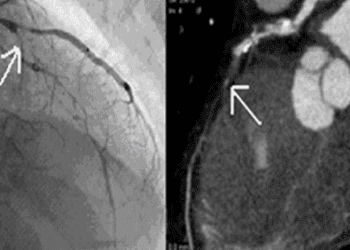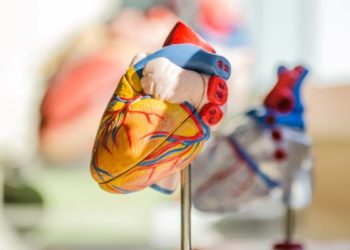Wearable cardioverter-defibrillators do not reduce mortality within 90 days of myocardial infarction
1. Patients with an acute myocardial infarction (MI) and ejection fraction less than 35% did not have reduced incidence of arrhythmic death within 90 days of the index MI compared to control patients.
2. Incidence of nonarrythmic death was also similar within 90 days of MI for patients in the device and control groups.
Evidence Rating Level: 1 (Excellent)
Study Rundown: Incidence of sudden cardiac death is elevated in the period following a MI. Implantable cardioverter-defibrillators (ICDs) have shown mortality benefits when implanted months after MI, but no mortality benefit has been shown for ICDs implanted acutely following MI. In this high-risk period wearable cardioverter-defibrillators may provide mortality benefit to patients before they undergo an ICD procedure. The Vest Prevention of Early Sudden Death Trial (VEST) assessed the efficacy of wearable cardioverter-defibrillators in patients up to 90 days post MI. The primary outcome of composite arrhythmic death at 90 days post-MI was not significantly different between the wearable device group and a control group. Rates of nonarrythmic death also did not differ between the groups, while death due to any cause was lower in the device group.
Strengths of this study include its randomized design, multinational patient recruitment, and training of patients on appropriate device use. Limitations include possible study underpowering for detection of the all-cause mortality outcome and difficulties in delineating arrhythmic from nonarrythmic causes of death.
Click to read the study in NEJM
Relevant Reading: Aggregate national experience with the wearable cardioverter-defibrillator: event rates, compliance, and survival
In-Depth [randomized controlled trial]: This multicenter, randomized controlled trial recruited patients between 2008 and 2017. Eligible patients were hospitalized for an acute MI and had an ejection fraction of 35% or less. Patients were enrolled in the study within 7 days of discharge. Exclusion criteria included having an ICD, were undergoing hemodialysis, or had a chest wall to small or large to accommodate the device. Randomization occurred in a 2:1 fashion, with patients in device (n=1524) or control (n=778) groups. Patients with the device were to wear it at all times for 3 months except when bathing. Follow-up occurred at 1 and 3 months. Median ejection fraction was 28%, and percutaneous coronary intervention during hospitalization occurred in 83.6% of patients. Patients in the device group wore the device for a median of 18 hours per day and for a mean of 14 hours per day. Mean follow-up was 84.3 days. Rates of arrhythmic death at 90 days were 1.6% in the device group and 2.4% in the control group (relative risk [RR], 0.67; 95% confidence interval [CI], 0.37 to 1.21; P=0.18). Death from all causes was 3.1% in the device group and 4.9% in the control group (RR, 0.64; 95% CI, 0.43 to 0.98; uncorrected P=0.04). Nonarrythmic death occurred in 1.4% of the device group and 2.2% of the control group (RR, 0.63; 95% CI, 0.33 to 1.19; uncorrected P=0.15). For patients wearing the devices, the average rate of alarms for possible arrhythmias was 0.033 alarms per hour. A shock was received by 29 patients in the device group, with 20 deemed appropriate and 9 deemed inappropriate shocks. Symptomatically, more patients in the device group reported itching and rash while fewer patients in the device group reported shortness of breath, as compared to the control group.
Image: PD
©2018 2 Minute Medicine, Inc. All rights reserved. No works may be reproduced without expressed written consent from 2 Minute Medicine, Inc. Inquire about licensing here. No article should be construed as medical advice and is not intended as such by the authors or by 2 Minute Medicine, Inc.







